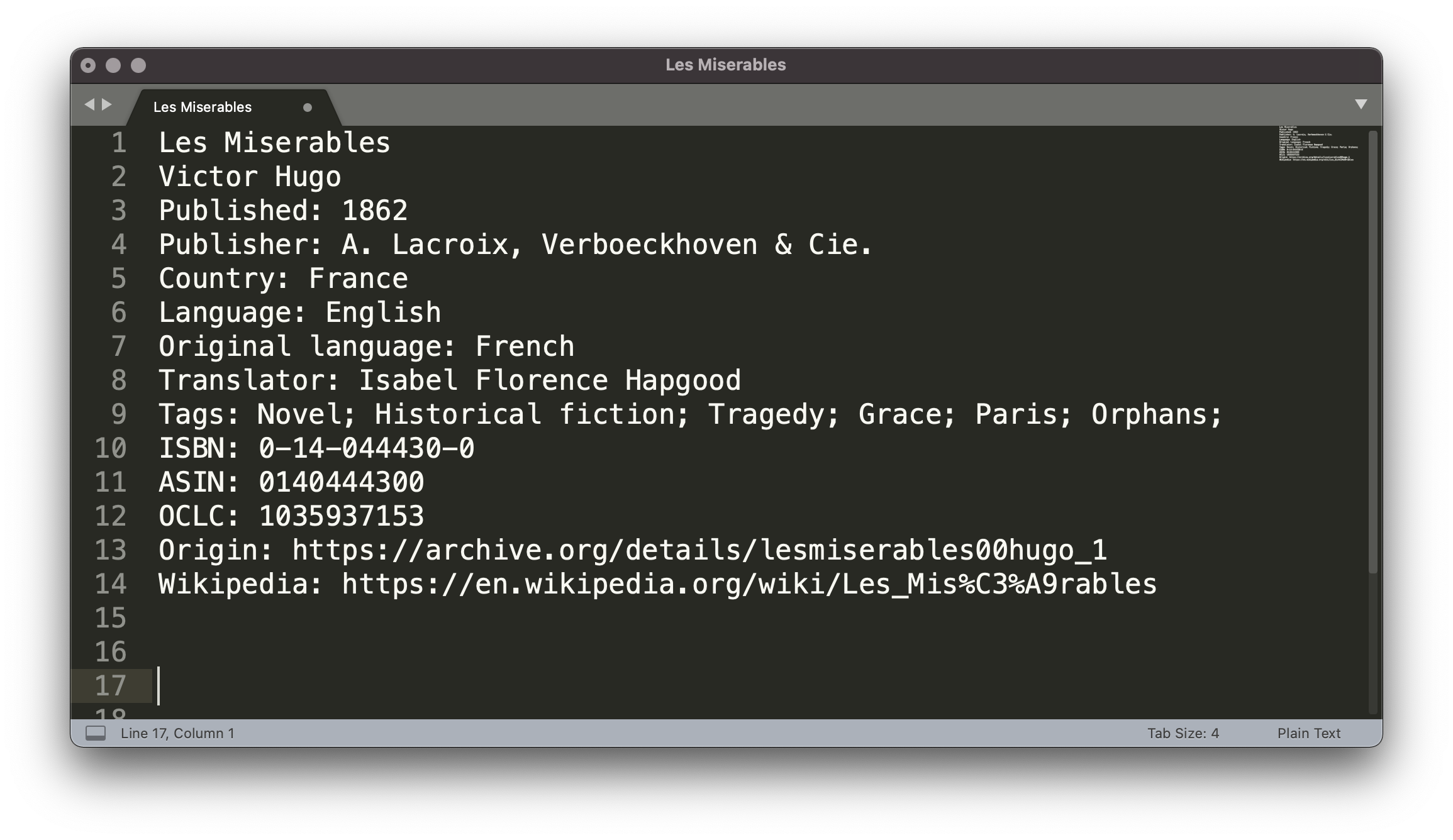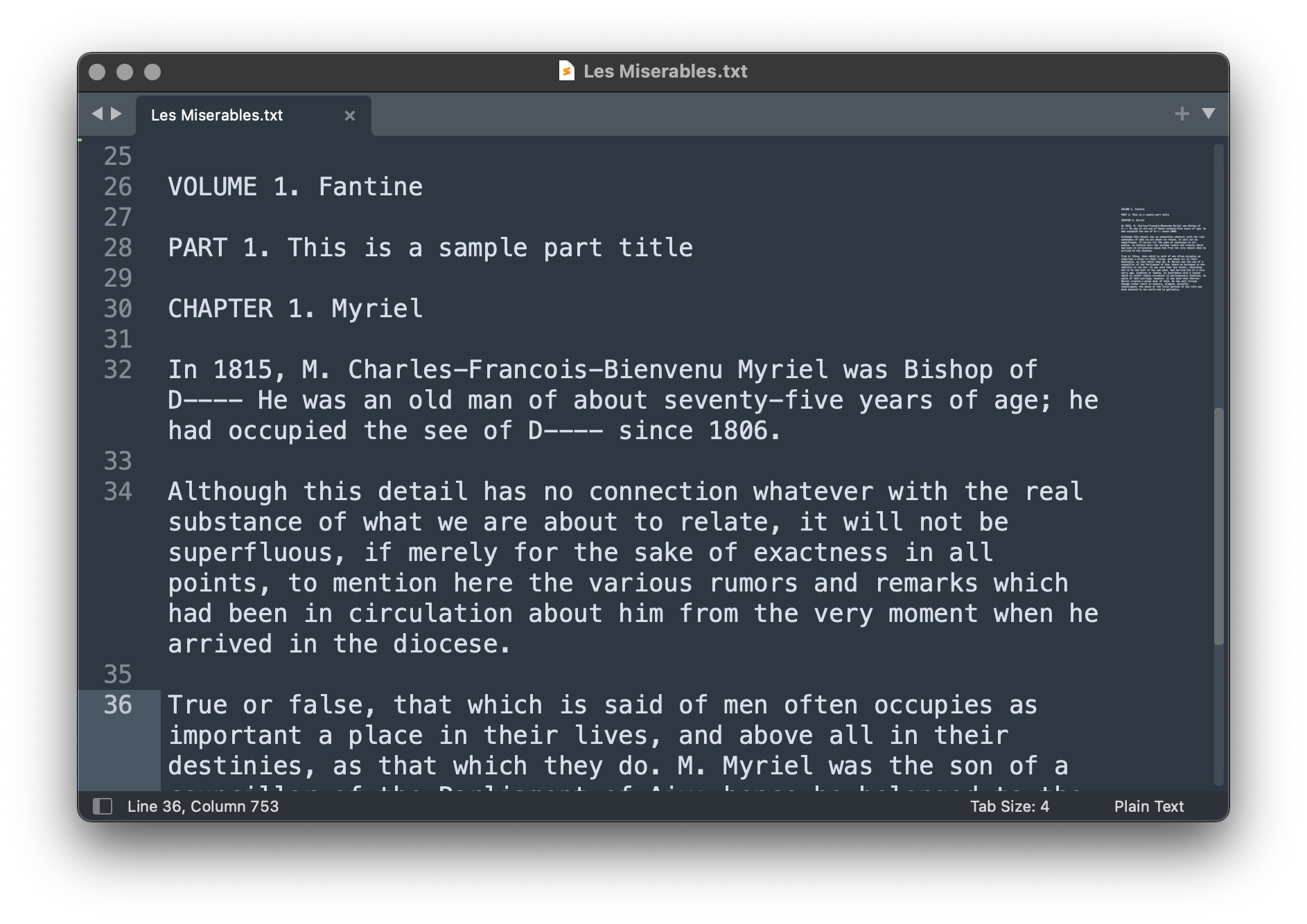How do I load a book?
TLDR: You can not currently add it yourself. Prepare a text file, send it to us and we will load it for you.

TLDR: You can not currently add it yourself. Prepare a text file, send it to us and we will load it for you.
We are working on making this process automated. Until then, follow these steps to get a book ingested into the site. The better you prepare it, the easier and quicker it will be for us to load.
First, find the book
- Find the book as a file (PDF, Word, plain text). Make sure the book or document is either in the public domain, or you have the rights to it.
- Convert that file into a simple text file. Export it, or simply copy/paste. We recommend you use a text editor like Sublime Text, Atom or Brackets. Save with UTF-8 encoding (use UTF-16 if the language of the work/book requires it). If you don't know what this is, send us a draft before you spend too much time on the steps below.
- Review the text file for accuracy and completeness. Replace strange characters; remove headers & footers; remove page numbers; Remove unnecessary
- Research and fill in any of the following metadata you can find about the book. It will help others find it without ambiguity. One line per concept. Like this:

This is the full collection of metadata items we collect. Skip the ones you just can't find, don't leave lines blank. If you can't find the "country" for example, then just don't add that metadata line.
- Les Miserables (the title of the book, needs no prefix)
- Victor Hugo (the author of the book, needs no prefix)
- Subtitle: Sample book subtitle, if applicable
- Alternate title: Another title this book is known as, if any
- Collection: If part of a series or a collection, write it here
- Published: 1862
- Translator: Isabel Hapgood
- Language: English
- Original language: French
- Producer: Whoever produced it, if you know
- Publisher: The original publisher
- Origin: Project Gutenberg
- Origin Id: 135
- Origin url: https://www.gutenberg.org/ebooks/135
- ASIN: 123456789101
- ISBN: 9780395951057
- Dewey Decimal: 943.086092
- LC Class: DD247.H5
- Title wiki: https://en.wikipedia.org/wiki/Les_Misérables
- Author wiki: https://en.wikipedia.org/wiki/Victor_Hugo
- Tags: Epic novel; Historical fiction; Tragedy; Grace; Pride; Character transformation; (separate these with a semicolon)
- Structure level 1 prefix: (leave it blank when not applicable)
- Structure level 2 prefix: PART (leave it blank if not applicable)
- Structure level 3 prefix: CHAPTER (leave it blank if there are no subdivisions for the title)
Then, structure it
- Structure the text by simply ensuring every "section" begins with its corresponding structural prefix. For example, "Les Miserables" contains volumes, which in turn contain "parts", which in turn contain chapters. So, you would make sure the headings look as follows.

Note that:
- The structure/section prefix is followed by a numeral (Arabic or Roman are fine, as long as they are consistent and they don't mix), then by a period, a space and then the title of the "section", if there is any.
- Each header should be separated from the body by at least two line breaks.
- Paragraphs do not need HTML markup.
- Fragmented paragraphs are OK, as long as their composing lines are separated by only one return.
- If you don't want the system to automatically join all paragraph lines into one, add a <br/> markup node (e.g. poems typically require capricious line breaks).
- If you want us to load an illustrated book, contact us and we'll work it out with you.
Advanced markup
There are some sections of the book that may require especial "markup". This means that we should add a special string to some paragraphs of the book. Use these lines and add them to the end of the paragraph as and if applicable. This is rare... if you find yourself adding these to the majority of the paragraphs of the tittle, stop and reach out to us and we will figure it out together.
General purpose markup:
- <TEXTOPIAN: Quote>
- <TEXTOPIAN: Poem>
- <TEXTOPIAN: Vignette>
- <TEXTOPIAN: Footnote>
- <TEXTOPIAN: Bullet>
- <TEXTOPIAN: Do not split this paragraph>
Headers. These apply when the text requires especial heading formatting. This does not apply to structural headers, rather, this only applies to sub-sections of a chapter, that should be formatted as a title within the chapter.
- <TEXTOPIAN: Header-1>
- <TEXTOPIAN: Header-2>
- <TEXTOPIAN: Header-3>
- <TEXTOPIAN: Header-4>
Images. For titles that we load with illustrations, we simply need to tell the system when a given paragraph should display an image. The images would need to be saved as separate .jpg or .png files, and the markup should link to them (locally, no need for a URL or to upload them, just sent us the whole package as a .zip file). Examples:
- <TEXTOPIAN image:"figure-1-1.jpg"/>
- <TEXTOPIAN image:"figure-0-0-0.jpg"/>
Find a book cover
Submit also a .jpg or .png file with the corresponding book cover. Selection criteria, apply these when possible:
- Find a large version of the cover (at least 300px tall).
- Look for a modern-looking book cover, that might entice the younger generations into reading it.
- Try to find a cover that is not copyrighted and that does not include the name of a specific publisher.
- Make sure the image is not a square... look for one with typical book cover dimensions ratio (eg. taller than wider).
By way of example:

Non-English titles
If you are preparing a book that is not in English, please ensure that:
- The author name is in English. The name of the author links the title to the author's profile. Use the author name we use in the site. If it is a new author, take a minute or two to make sure you use the most popular, common or official name of the author.
- The text is separated into paragraphs.
Share it
Send it to us via email, to help@textopian.com, and tell us if you want the book added to the general collection, or to a specific group.
Wait for about 3-7 days, since depending on the requests volume, we may not be able to get to it right away.
